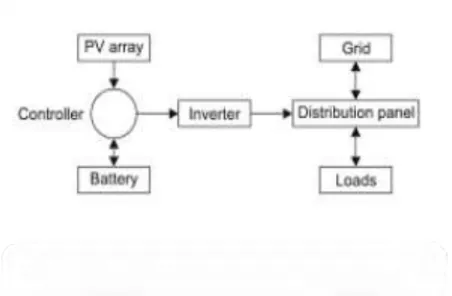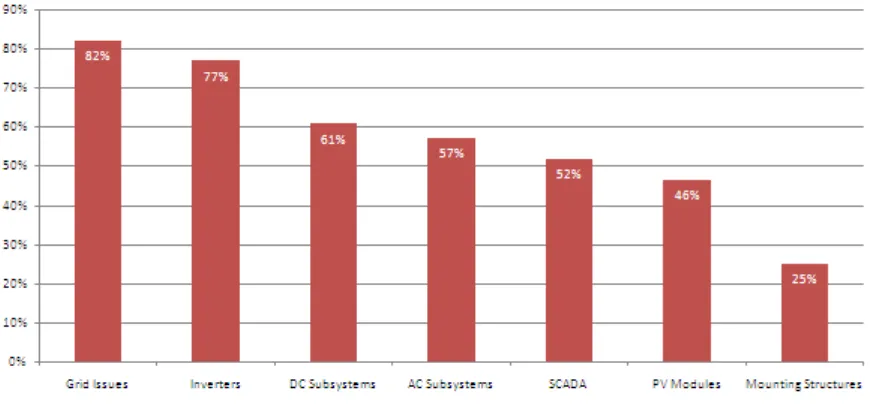UNIVERSITI TEKNIKAL MALAYSIA MELAKA
THE STUDY OF ASSET MAINTENANCE PRACTICES FOR
SOLAR PHOTOVOLTAIC (PV) SYSTEM IN MALAYSIA
This report submitted in accordance with requirement of the Universiti Teknikal Malaysia Melaka (UTeM) for the Bachelor’s Degree in Electrical Engineering
Technology (Industrial Power) With Honours.
by
NOR SYAZANA BINTI HASAN B071210230
930118115358
UNIVERSITI TEKNIKAL MALAYSIA MELAKA
BORANG PENGESAHAN STATUS LAPORAN PROJEK SARJANA MUDA
TAJUK: The Study of Asset Maintenance Practices for Solar Photovoltaic (PV) System in Malaysia.
SESI PENGAJIAN: 2015/2016 Semester 1
Saya NOR SYAZANA BINTI HASAN
mengaku membenarkan Laporan PSM ini disimpan di Perpustakaan Universiti Teknikal Malaysia Melaka (UTeM) dengan syarat-syarat kegunaan seperti berikut:
1. Laporan PSM adalah hak milik Universiti Teknikal Malaysia Melaka dan penulis. 2. Perpustakaan Universiti Teknikal Malaysia Melaka dibenarkan membuat salinan
untuk tujuan pengajian sahaja dengan izin penulis.
3. Perpustakaan dibenarkan membuat salinan laporan PSM ini sebagai bahan pertukaran antara institusi pengajian tinggi.
FAKULTI TEKNOLOGI KEJURUTERAAN PROJEK SARJANA MUDA TEKNOLOGI KEJURUTERAAN (BETI): NOR SYAZANA BINTI HASAN
Sukacita dimaklumkan bahawa Laporan PSM yang tersebut di atas bertajuk “The Study of Asset Maintenance Practices for Solar PV in Malaysia”mohon dikelaskan sebagai *SULIT / TERHAD untuk tempoh LIMA (5) tahun dari tarikh surat ini.
Sekian dimaklumkan. Terima kasih.
Yang benar,
________________
Tandatangan dan Cop Penyelia
* Potong yang tidak berkenaan
NOTA: BORANG INI HANYA DIISI JIKA DIKLASIFIKASIKAN SEBAGAI SULIT DAN
TERHAD. JIKA LAPORAN DIKELASKAN SEBAGAI TIDAK TERHAD, MAKA BORANG
iv
DECLARATION
I hereby, declared this report entitled “The Study of Asset Maintenance Practices for Solar PV in Malaysia” is the result of my own research except as cited in references.
v
APPROVAL
This report is submitted to the Faculty of Engineering Technology of UTeM as a partial fulfillment of the requirements for the degree of Bachelor of Engineering Technology in Electric (Power Industry). The member of the supervisor is as follow :
………. (Emy Zairah Binti Ahmad)
vi
ABSTRACT
vii
ABSTRAK
viii
DEDICATIONS
To my beloved parents
Hasan Bin Daud & Che Yah Binti Ayub
Siblings
ix
ACKNOWLEDGMENTS
I would like to express heartfelt gratitude to my supervisor Mr.Muhammad Sharil Bin Yahaya from Department of Electrical Engineering Technology for his patience guidance, enthusiastic encouragement and for giving me the opportunity to study with him about exciting case study for my thesis. His support and constructive suggestions were the most important assets that led this thesis are almost complete.
xi 2.8.1 Maintenance for alkaline battery 24
xii
CHAPTER 4: RESULTS AND DISCUSSION 38
4.1 Result Analysis 38
4.1.1Result for general questions 39
4.1.2Result for PV Module questions 44
4.1.3Result for Inverter questions 48
4.1.4Result for Battery Storage questions 52 4.1.5Result for Support Structure questions 56 4.1.6Result for AC/DC Subsystem questions 59
4.1.7Result for others questions 62
CHAPTER 5: CONCLUSION AND RECOMMENDATION 65
5.1 Conclusion 65
5.2 Recommendation 67
5.3 Limitation 67
xiii
2.8 Current, Voltage and Power Characteristics 16
2.9 Support structure 16 2.10 Bolt rusting 17
2.11 CCTV control & proper signage 18 3.1 Draft of graph 1 36 3.2 Draft of graph 2 37 4.1.1a Percentage of respondents that know about maintenance 40
4.1.1b Percentage of respondents that their company provide maintenance 40 4.1.1c Percentage of respondents that have installation experiences 41 4.1.1d Percentage of respondents that their company provide warranty 42 4.1.1e Percentage of respondents due to common problems of PV system 43
4.1.2a Percentage of respondents due to failure on PV module 45 4.1.2b Percentage of respondents due to maintenance activity 45 4.1.2c Percentage of respondents based on period recommended 46
4.1.2d Percentage of respondents due to warranty 47
4.1.3a Percentage of respondents due to failure on Inverter 49 4.1.3b Percentage of respondents due to maintenance activity 49 4.1.3c Percentage of respondents based on period recommended 50
xiv
xv
LIST OF TABLE
2.1 Over-shading 10
4.11a Result for general questions 39
4.12a Result for PV Module questions 44
4.13a Result for Inverter questions 48
4.14a Result for Battery Storage questions 52
4.15a Result for Support Structure questions 56
4.16a Result for AC/DC Subsystem questions 59
1 level of the performance and high reliability from the solar asset. This will provide the information needed to make a sensible and informed decision whether a PV system is work as it should or not. Therefore, the requirements knowledge of each components in PV system should be taken into account for establishing detailed procedure or give more information about the maintenance needed.
1.2 Background
2
environment factors or problems that cause the uses of renewable energy becoming popular nowadays.
Since this affordable energy resource is continue to be a fastest-growing sector in the market, it plays an important resource that consumers trust it will gives the maximum efficiency during process of delivery the electricity energy. Thus, one of the most important things to make sure the PV system have maximum performance of efficiency is by focus on their operation and maintenance (O & M) without just look at its appropriate design and construction.
Thus, the standardized procedures for operations and maintenance (O&M) checking are required to unsure that PV system has high reliability and operation that may improve lifetime performance and energy production. Like any other equipment or system installation, it is very essential to perform a well maintenance because it can help maximize uptime and minimize the risks of downtime. In solar system, a well maintained can actually give up to 30% better than that is not in energy production because of no noise or disruption during delivery of solar power.
3
Therefore, this report will be a guideline about the operation and maintenance (O&M) need for all the components in PV system. The modules, battery and inverter or power conditioning unit is an example of the several main components of PV system that work together to produce the electricity direct from sunlight and known as a renewable energy. This guideline is good practices and should be an important reference that can be used before or after testing, design and construction to optimizing performance, reliability and safety.
1.3 Problem Statement
In facing of increasing installation of photovoltaic (PV) system, the standardized procedures for operations and maintenance (O&M) practices or checking are required to ensure that PV system has high reliability and operation that may improve lifetime performance and energy production. Therefore the following questions or challenges are required to overcome, which are :
i. Does an asset maintenance practices for PV system have been done in Malaysia?
ii. What are common problems or failure area of solar PV that required for maintenance?
4 1.4 Objectives
The objectives of this research are to know and solve the problem or common failure area of PV system to make sure it will achieve the highest level of performance by minimize the risks or possibility of downtime and to make sure it work more effectively as a trusted renewable energy. It is included :
i. The study or know of asset maintenance practices for solar PV system in Malaysia.
ii. Study about the common problems or failure area of solar PV maintenance that have been done in Malaysia.
iii. Study and explore the problem or failure area of solar PV that required the routine maintenance.
1.5 Scopes
The scopes of this research are as follows:
i) The study covers about the solar PV system in Malaysia, only for solar farm and grid connected
ii) The data will be obtained through interviews of a few persons, distribute the questionnaires and perform a site visit
5
iv) The most effective maintenance practices will be justified and the data will be presented statistically or in form of graph
1.6 Thesis Organization
6
CHAPTER 2
LITERATURE REVIEW
2.1 PV System Component
Grid-connected of PV system that may and not may use any battery is divided into two categories which are, grid-connected for small power application that have power ratings in the range 1KW above such as households, and grid-connected for large power application that normally have power ratings in the range of 1MW above such as solar power plants. The main components of grid-connected PV systems are PV modules, inverter or power conditioning unit and loads. The use of battery can be avoided as much as possible when the PV system is connected to grid as energy storage medium. Although the batteries is expensive for large system, but sometimes it is also added to ensure that loads always get the energy, even if grid power is not available.[1]
7
As mentioned above, the grid-connected of PV system is composed of a variety of equipment or components (figure 2.2) that make it capable to supply energy and the basic function of these components are :
Figure 2.1: Main components of PV system [2]
a) Photovoltaic cells that made from semiconductor is used to convert the electricity from sunlight. It is connected together with modules to produce a large power output of photovoltaic cells and this module is called as panels and arrays when connected in series and parallel to form larger units to produce energy that covers almost any electric need.
8
deliver electrical energy, but can’t be recharged. Thus, this type of batteries is not used in PV systems. While for a secondary battery, it is also can store and deliver electrical energy, but can be recharged by passing a current through it in an opposite direction to the discharge current. This type of batteries such as lead-acid batteries is used in PV system.
c) An inverter is an electrical device that used to convert the direct-current (DC) electricity to alternating-current (AC) electricity. There are several types of inverter in grid connected system which is string, micro and multi-string inverter. String inverters with no diode loss are connected in series with an AC module. Each string has separate MPP tracking and lower cost with mass productions and also can be implement with high voltage MOSFET/IGBT. Although it is quite popular during introduced, but the MPP tracking is still not sufficient to achieve a certain efficiency requirement. Micro-inverter is a good mass production that potentially leads to low manufacturing and have no PV mismatch due to it only have one PV control that can maximize efficiency. While for multi-string inverter, it has features that can optimal MPP tracking for a single string of PV system. [4]
d) DC loads are appliances, motors and other equipment that powered by direct current.
e) AC loads are appliances, motors and other equipment that powered by alternating current.
9
Figure2.3 : The major of failure area at PV system [5]
2.2 Photovoltaic Module
Figure 2.4: The PV Module at Gading Kencana

![Figure 2.1: Main components of PV system [2]](https://thumb-ap.123doks.com/thumbv2/123dok/484956.53219/22.612.150.467.185.390/figure-main-components-of-pv-system.webp)
